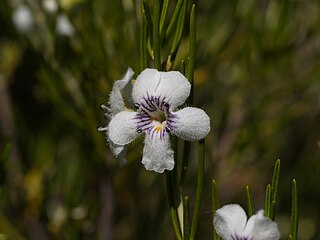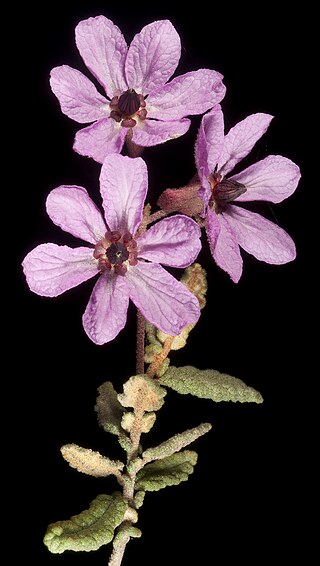Micromyrtus hymenonema is a species of flowering plant in the myrtle family, Myrtaceae and is endemic to inland areas of Western Australia. It is a shrub with overlapping, decussate linear leaves and pink flowers arranged singly in leaf axils with about 10 stamens in each flower.
Micromyrtus prochytes is species of the flowering plant in the family Myrtaceae and is endemic to inland areas of Western Australia. It is an erect shrub with narrowly egg-shaped leaves with the narrower end toward the base, and white or pink flowers 3.0–4.0 mm (0.12–0.16 in) in diameter.
Thryptomene eremaea is a species of flowering plant in the family Myrtaceae and is endemic to Western Australia. It is an erect shrub with upward-pointing, oval leaves and white or pale pink flowers with five petals and ten irregularly arranged stamens.

Philotheca gardneri is a species of flowering plant in the family Rutaceae and is endemic to the south-west of Western Australia. It is a shrub with crowded, narrow club-shaped or more or less spherical leaves and white flowers with a prominent pink midrib, usually borne singly on the ends of branchlets.

Prostanthera campbellii is a species of flowering plant in the family Lamiaceae and is endemic to the south-west of Western Australia. It is an erect shrub with linear leaves and white to cream-coloured flowers with purple striations.

Goodenia katabudjar is a species of flowering plant in the family Goodeniaceae and is endemic to a restricted area in the south-west of Western Australia. It is a hairy perennial sub-shrub with egg-shaped stem-leaves and blue, pink or white flowers.
Lysiosepalum hexandrum is a species of flowering plant in the family Malvaceae and is endemic to the south-west of Western Australia. It is dense, erect shrub with its young branches covered with woolly, star-shaped hairs, and has linear or narrowly elliptic leaves and blue, purple or pink flowers usually in groups of five.

Lysiosepalum rugosum, also known as the wrinkled-leaf lysiosepalum, is a species of flowering plant in the mallow family and is endemic to the south-west of Western Australia. It is shrub with its young branches covered with woolly, star-shaped hairs, and has narrowly egg-shaped leaves and blue, purple of pink flowers usually in groups of 4 to 6.
Lasiopetalum lineare is a species of flowering plant in the family Malvaceae and is endemic to the south-west of Western Australia. It is an erect shrub with densely hairy young stems, linear leaves and bright pink and dark red flowers.

Stenanthemum intricatum is a species of flowering plant in the family Rhamnaceae and is endemic to the southwest of Western Australia. It is an erect to spreading, often wiry shrub with sparsely hairy young stems, egg-shaped to fan-shaped leaves and greyish, densely softly-hairy heads of white or cream-coloured flowers.
Stenanthemum limitatum is a species of flowering plant in the family Rhamnaceae and is endemic to the southwest of Western Australia. It is an erect or straggling shrub with sparsely hairy young stems, egg-shaped to fan-shaped leaves and greyish, softly-hairy heads of white or cream-coloured flowers.

Conostephium magnum is a species of flowering plant in the family Ericaceae and is endemic to the south-west of Western Australia. It is an erect, compact shrub with scattered lance-shaped leaves with the narrower end toward the base, and pendulous, spindle-shaped, cream-coloured to white and pink flowers arranged singly in leaf axils.
Guichenotia anota is a flowering plant in the family Malvaceae and is endemic to a restricted part of the southwest of Western Australia. It is a low, erect, compact shrub with hairy new growth, oblong to narrowly egg-shaped leaves, and pinkish-purple flowers.
Brachyloma delbi is a species of flowering plant in the family Ericaceae and is endemic to a small area in the south-west of Western Australia. It is an erect, open shrub with linear leaves and pink to red, tube-shaped flowers.
Brachyloma djerral is a species of flowering plant in the family Ericaceae and is endemic to a small area in the west of Western Australia. It is an erect, compact shrub with narrowly egg-shaped to narrowly elliptic leaves and red, tube-shaped flowers.
Brachyloma elusum is a species of flowering plant in the family Ericaceae and is endemic to a two locations in the west of Western Australia. It is an erect, compact shrub with linear to narrowly egg-shaped leaves with the narrower end toward the base, and red, tube-shaped flowers.
Brachyloma geissoloma is a species of flowering plant in the family Ericaceae and is endemic to the south of Western Australia. It is an erect, bushy shrub with oblong or lance-shaped leaves with the narrower end toward the base, and red, pink or white, tube-shaped flowers.
Brachyloma nguba is a species of flowering plant in the family Ericaceae and is endemic to the south-west of Western Australia. It is a shrub with narrowly elliptic leaves on the ends of short side-branches, and red urn-shaped flowers.
Brachyloma pirara is a species of flowering plant in the family Ericaceae and is endemic a restricted area in the west of Western Australia. It is an erect, compact shrub with sharply-pointed, linear to narrowly egg-shaped or narrowly elliptic leaves, and red, tube-shaped flowers.
Brachyloma stenolobum is a species of flowering plant in the family Ericaceae and is endemic to a restricted area in the west of Western Australia. It is an erect, compact shrub with narrowly elliptic or elliptic leaves, and white, tube-shaped flowers.






